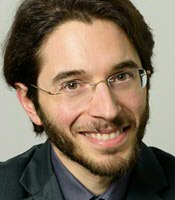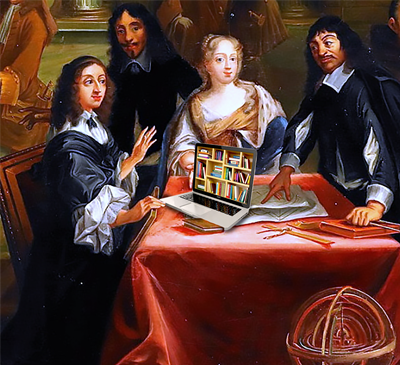Revisiting the philosophical canon using Artificial Intelligence

The pressure to publish and red tape is increasingly forcing philosophy scholars to confine themselves to ‘a few great works by a few great authors’. And that can be quite problematic when your core objective is to engage in deep reflection, especially if you want to paint an accurate and complete picture of one of the most influential branches of philosophy in history: early modern natural philosophy. This prompted Dr Andrea Sangiacomo of the Faculty of Philosophy to enlist the help of the Data Science team at the Centre for Information Technology (CIT), which was able to generate refreshing insights using Artificial Intelligence.
Author: Jorn Lelong
‘Our entire understanding of early modern philosophy is based on the works of five authors. So naturally, that is an incredibly distorted view. But what is the alternative?’ Andrea Sangiacomo had been wrestling with that question for some time. His interest in early modern natural philosophy, the period (17th-18th centuries) in which philosophy and science were intertwined, was sparked by Spinoza. Due to the major scientific developments that were taking place at that time, early modern natural philosophy is also seen as the forerunner of modern science. At the same time, it was a rich era of philosophical thought that produced a number of authors who, to this day, continue to dominate many philosophy courses: Spinoza, Descartes, Hume, Locke, Newton and, at least according to some, Kant.
AI to the rescue
But, according to Sangiacomo, by focusing on those key figures, our perception of the early modern period is anything but representative. ‘I realized that I would never be able to gain a complete picture of that period. Because if it turns out that there were actually as many as a thousand philosophers active during that time, what would be the advantage of adding ten to fifteen names to the existing canon? We need new tools.’ As such, Sangiacomo looked to other fields of research facing similar problems. Inspired by the work of Franco Moretti, who tried to use machine learning models to challenge the literary canon, he thought Artificial Intelligence could be a valuable tool.

Data Science call for proposals
Sangiacomo’s research was one of the projects selected as part of the annual Data Science call for proposals launched by the Center for Information Technology (CIT). He received 450 hours of support from CIT’s Data Science team. Sangiacomo and data scientist Cristian Marocico joined forces to examine how scientific concepts evolved during the 17th and 18th centuries. They used ShiCo (Shifting Concepts through Time), an open source tool developed by the Netherlands eScience Center and the University of Utrecht, to analyse shifts in words in a historical context.
70,000 letters
Of course, the tool needed a little tinkering. ShiCo was developed to record conceptual shifts in 20th-century newspaper reports. Data scientist Marocico adapted the model so that the algorithm was able to analyse 70,000 letters exchanged between philosophers and academics during the 17th and 18th centuries. They retrieved that huge corpus, consisting mainly of letters written in English and French, but also in Portuguese and Latin, from the Oxford Electronic Enlightenment database. They investigated which word associations were formed for certain scientific concepts, and how this changed over the years. Sometimes this produced remarkable results. ‘For example, we found that in the 17th century the English word “spirit” was used in both a chemical and a religious context. In the 18th century, however, we see that the word has lost its chemical meaning. It illustrates how concepts change. Or how a 17th-century work, for example, can take on a different meaning in the 18th century. This also influences which authors stand the test of time and which do not,’ says Sangiacomo.

The importance of a network
Sangiacomo also found that social connections also have a significant role to play in the popularity of certain philosophical theories. As such, in addition to the shifts in meanings, he also sought to trace the mutual relationships and networks of early modern philosophers. ‘A priori, there are no obvious reasons as to why some philosophical theories become much more popular than others. Throughout history you sometimes see that really crazy ideas become mainstream, while good ideas are side-lined. To explain that, you have to look at social connections, because people are the real driving force of history. In that respect, this project provides a lot of information.’
The position of female philosophers
In one of Sangiacomo’s sub-studies, he focused on the position of female philosophers in the early modern period. Because, despite the fact that there were many prominent female philosophers at that time, they are not part of the canon today. And this means that their contributions are easily overlooked. ‘I was surprised how many female philosophers there were, and how many connections they had – including with the philosophers we know today. But at the same time we also found that female philosophers had very little contact with each other, and were always dependent on the network of a well-known male author.’
Lab microscope
Depending on the parameters you enter, you can use the machine learning model to test many different hypotheses. ‘Once you have trained the algorithm, it is actually just an advanced search engine that you can easily adapt to your research question,’ explains data scientist Cristian Marocico. Sangiacomo prefers a different comparison. ‘Every time I come up with a new question or am curious about something, I can go back to the tool and adjust it accordingly. It is a bit like a microscope in a lab. You do not just push that aside after one successful observation.’
A job for humans
However refreshing it may be, Sangiacomo is still out on his own with his approach for the time being. ‘Many colleagues still consider philosophy to be purely a job for humans. And do not get me wrong, I generally agree with that. The most relevant philosophical insights are still being generated by people who reflect deeply.’ He believes that it is particularly important to know what you want to achieve with your research, and how other technologies and methods, such as data science, can help with that. ‘Data science can be very useful, but you always have to ask yourself the question: are these things philosophically relevant? In the end, it only gives you numbers. To interpret these numbers, you still have to think for yourself. But fortunately, that is what we philosophers like to do.’
ERC grant
For the follow-up research project, the European Research Council (ERC) awarded Andrea Sangiacomo a research grant of €1.5 million. The ERC supports talented young researchers in setting up a research team and launching a ground-breaking research project.
More information
More news
-
08 December 2025
Citizen participation essential for a sustainable energy future
-
02 December 2025
Trust in science requires integrity in communication
-
28 October 2025
The search for responsibility in the financial world
